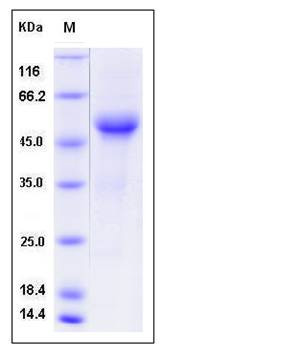Human CD8B / P37 / LEU2 Protein (Fc Tag)
CD8B1,LEU2,LY3,LYT3,P37
- 100ug (NPP3719) Please inquiry
| Catalog Number | P11031-H02H |
|---|---|
| Organism Species | Human |
| Host | Human Cells |
| Synonyms | CD8B1,LEU2,LY3,LYT3,P37 |
| Molecular Weight | The recombinant human CD8B/Fc is a disulfide-linked homodimeric protein. The reduced monomer consists of 390 amino acids and has a predicted molecular mass of 44 kDa. The apparent molecular mass of the reduced monomer is approximately 50 kDa in SDS-PAGE under reducing conditions. |
| predicted N | Leu 22 |
| SDS-PAGE |  |
| Purity | > 93 % as determined by SDS-PAGE |
| Protein Construction | A DNA sequence encoding the human CD8B isoform 1 (P10966-1) extracellular domain (Met 1-Pro 170) was fused with the Fc region of human IgG1 at the C-terminus. |
| Bio-activity | |
| Research Area | Immunology |Cluster of Differentiation (CD) |T Cell CD Antigen |
| Formulation | Lyophilized from sterile PBS, pH 7.4 1. Normally 5 % - 8 % trehalose and mannitol are added as protectants before lyophilization. Specific concentrations are included in the hardcopy of COA. |
| Background | CD8B (CD8b molecule), also known as P37 and LEU2, contains 1 Ig-like V-type (immunoglobulin-like) domain. The CD8 antigen is a cell surface glycoprotein found on most cytotoxic T lymphocytes that mediates efficient cell-cell interactions within the immune system. The CD8 antigen, acting as a coreceptor, and the T-cell receptor on the T lymphocyte recognize antigens displayed by an antigen presenting cell (APC) in the context of class I MHC molecules. The functional coreceptor is either a homodimer composed of two alpha chains, or a heterodimer composed of one alpha and one beta chain. Both alpha and beta chains share significant homology to immunoglobulin variable light chains. P37 gene encodes the CD8 beta chain isoforms. Multiple alternatively spliced transcript variants encoding distinct membrane associated or secreted isoforms have been described. A pseudogene, also located on chromosome 2, has been identified. CD8 is thought to play a role in the process of T-cell mediated killing. |
| Reference |
